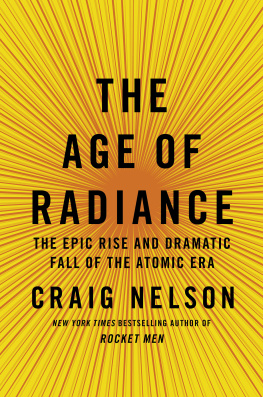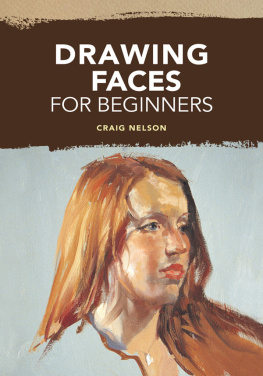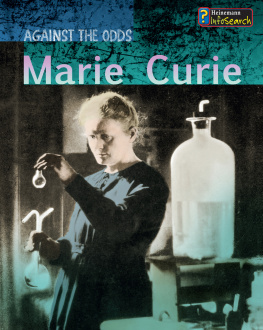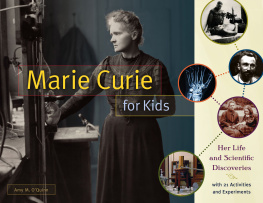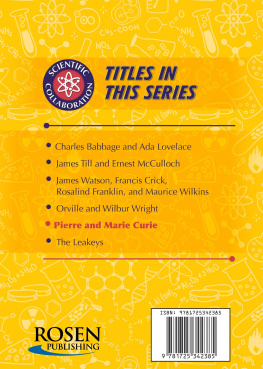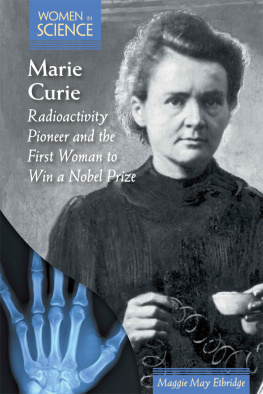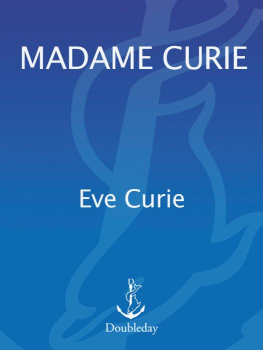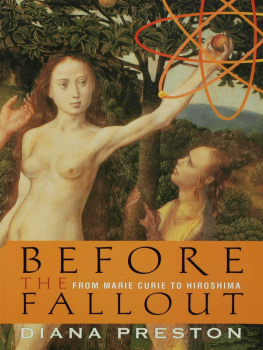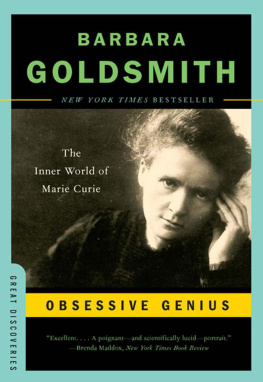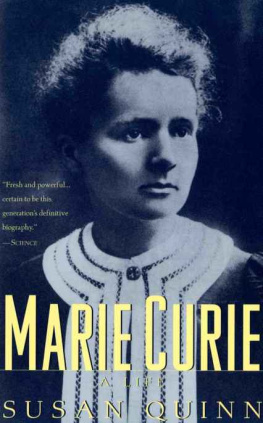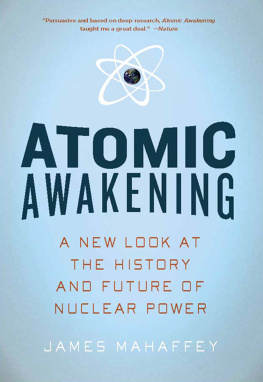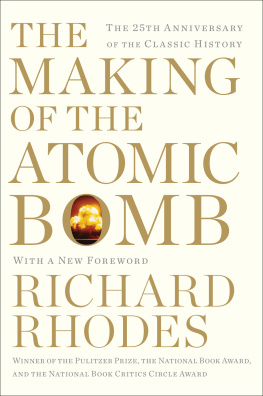Thank you for downloading this Scribner eBook.
Join our mailing list and get updates on new releases, deals, bonus content and other great books from Scribner and Simon & Schuster.
C LICK H ERE T O S IGN U P
or visit us online to sign up at
eBookNews.SimonandSchuster.com
We hope you enjoyed reading this Scribner eBook.
Join our mailing list and get updates on new releases, deals, bonus content and other great books from Scribner and Simon & Schuster.
C LICK H ERE T O S IGN U P
or visit us online to sign up at
eBookNews.SimonandSchuster.com
CONTENTS
For StuartYou are the best in the world at what you do.
The most beautiful and deepest experience a man can have is the sense of the mysterious. It is the underlying principle of religion as well as of all serious endeavor in art and science. He who never had this experience seems to me, if not dead, then at least blind.
A LBERT E INSTEIN
Nothing in life is to be feared, it is only to be understood. Now is the time to understand more, so that we fear less.
M ARIE C URIE

1
Radiation: Whats in It for Me?
Y ESTERDAY you dashed your breakfast eggs with dried spices that had been irradiated against bacteria, germination, and spoilage. The secret ingredient in the microwave oven reheating that mornings to-go coffee was radioactive thorium, first isolated from hearty Scandinavian minerals and named for their tempestuous lord. Your kitchens smoke + CO2 detector then started beeping every thirty seconds since it had to be replacedits 0.9 micrograms of americium-241 had expired. The Brazil nuts in your cereal, meanwhile, had a thousand times more radium than any other food eaten by modern humans. Your bananas potassium was radioactive, as was the body of the person you slept next to the night before. All night long you returned the favor, two lovers irradiating each other across snores, dreams, and twitching REM eyes.
Since you live at sea level, you get an annual cosmic-ray shower of thirty millirems ( r oentgen e quivalent m an (or m ammal), a measure of the cancerous effects of radiant emanations, with one rem meaning .055 percent chance of cancer), but moving to Denver with its increased elevation will double that, while an aviation career equals 1 mrem for every thousand miles soaring at thirty thousand feet. Living in a home of masonrystone, brick, adobedoses you with 7 mrems annually, and in a city of buildings made from those same types of earth, 10 mrems, with an extra shot every time you pass through halls of granite, such as New Yorks Grand Central Terminal or Washingtons Capitol (which is so vibrant it would fail the Nuclear Regulatory Commissions licensing conditions for a reactor site).
Visiting the dentist, you are draped in a lead apron but, even so, get another 80 mrems, as you would with a chest X-ray, CAT scan, or nuclear stress test. Theres uranium in your dental work, added to porcelain for long-lasting whiteness and fluorescence, and if you walk too closely by certain policemen after a dental or medical procedure, youll set off their Geiger counters (otherwise engaged in the hunt for mythic dirty bombs). On the way home, you bought a balloon for your daughter, the helium that made it float produced by all-natural, all-organic radioactivity within the planets mantle. Your delinquent nephew still smokes, inhaling 12,000 to 16,000 mrem every year from radon isotopes trapped in tobaccos delicious leaves. As you watch the glittering skyline of New York City on your way home that night, 30 percent of its power draws from a nuclear reactor that, if it suffered a Chernobyl-like failure, would mean the evacuation of 10 million people.
Your family is radioactive; your friends are radioactive; your pets are radioactive; and the earth itself throws off a gaseous froth of radon, 200 mrem for each of us, as uranium and thorium decay within the planets restive loam. Your vacation at a health spa includes daily bathing in mineral waters, but doesnt include the information that hot springs are hot in two sensesthe water is heated by rocks burning from those same uranium and thorium emissions, the force that also powers earthquakes to tremor, and volcanoes to erupt. Physicist Paul Preuss: What spreads the sea floors and moves the continents? What melts iron in the outer core and enables the Earths magnetic field? Heat. Geologists have used temperature measurements from more than 20,000 boreholes around the world to estimate that some 44 terawatts (44 trillion watts) of heat continually flow from Earths interior into space. Where does it come from? Radioactive decay of uranium, thorium, and potassium in Earths crust and mantle is a principal source.
Radiation is so organic that in 1972, geologic evidence of fourteen naturally occurring nuclear reactors, 1.5 billion years old, were found in the Oklo mines of Gabon, Central Africa. When groundwater leaked into a radiant vein of pitchblende ore unusually dense with that rare and quick-to-fission isotope uranium-235, the water slowed the energies of the free-range neutrons that make uranium radioactive, until their bouncing around like multiple strikes on a hundred-ball pool table triggered a chain reaction of neutrons splitting nuclei, which creates more free-range neutrons, splitting more nuclei. When the water boiled away, the natural ore reactors shut down... until more seeped back in, and they started up all over again.
In real life, though, you are not imperiled by Brazil nuts, bananas, microwave ovens, smoke detectors, going to the dentist, working as a flight attendant, sleeping with a lover, visiting Gabon, or living in Denver. Even with these daily accumulations, a scientific majority believes that you would need over 10,000 mrem to get any increased cancer risk, and 200,000 for radiation sicknessso only your smoking nephew is in trouble. Though tobacco companies knew as early as 1959 that cigarettes were rife with polonium-210, they kept that fact quiet for over four decades, even after discovering that acid-washing could remove 99 percent of the problembut deciding that it wasnt worth the costresulting in 138 deaths per 1,000 smokers per twenty-five years. And for those concerned about Denver, even though elevated Colorado gets between two and three times the cosmic-shower radiation of New Jersey, cancer rates in New Jersey are higher than they are in Colorado.
Irrational. Confusing. Conflicted. These are hallmarks of the whole of nuclear history. What was once an era heralded by Curie, Einstein, and Oppenheimer became degraded to Dr. Strangelove , $50 billion wasted on Reagans failed Star Wars, the 1979 partial meltdown at Three Mile Island, the 1986 explosion at Chernobyl, and the 2011 crisis at Fukushima. We are now living in the twilight of the Atomic Age, the end of both nuclear arsenals and nuclear power, yet, simultaneously, radiation has become so ubiquitous in contemporary life that it is nearly invisible, at once everywhere and unnoticed. It is the source of medical diagnostics from X-rays to PET scans and barium tracers, as well as a significant weapon in vanquishing certain cancers; it powers submarines and aircraft carriers; provides 20 percent of Americas domestic energy (and 80 percent of Frances); is used by anthropologists and forensic scientists to date biological remains, and by farmers to destroy bacteria; it remains a Pentagon mainstay and a weapon held dear by a club of developing nations who see it both as a route to global prestige... and the ultimate in defense against that same Pentagon.
Next page
